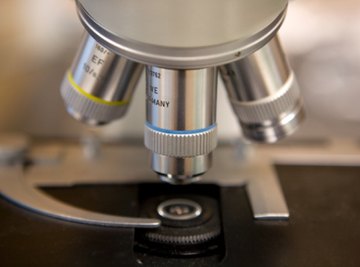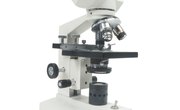
A typical microscope, a compound microscope, uses several lenses and a light source to greatly enhance the image of the object you are viewing. The compound microscope uses a system of lenses that work together to increase the size of the image. These lenses are made of a type of glass, called optical glass, that is much clearer and purer than normal everyday glass.
Objective Lens
The objective lens is the lens closest to the slide or object you are viewing. The purpose of the objective lens is to gather light and enhance magnification. A typical compound microscope will have four objective lenses: one scanning lens, low-power lens, high-power lens, and an oil-immersion lens. These lenses have a magnification power of four, 10, 40 and 100, respectively. The shorter the lens, the lower magnification power it has. These four lenses are interchangeable and usually parfocal, meaning you never lose focus of the image even while changing from one lens to the next.
Ocular Lens
The ocular lens, or eyepiece lens, is the one that you look through at the top of the microscope. The purpose of the ocular lens is to provide a re-magnified image for you to see when light enters through the objective lens. The ocular lens is generally 10- or 15-times magnification. The power of the ocular lens combines with the objective lens to allow a much larger and clearer image, with a total magnification (assuming the ocular lens has 10-times magnification) of 40, 100, 400, and 1000 times.
Condenser Lens
The condenser lens focuses light from the light source onto the slide or object, which feeds into the objective lens. The condenser lens is under the slide platform and above the light source. The amount of light allowed into the condenser lens can be altered by using the diaphragm. The amount of light allowed in will need to be adjusted whenever you use a different objective lens to see the object. Condenser lenses are more useful when the magnification is 400 times or higher, and best when using an oil-immersion lens.
Oil-Immersion Lens
The oil-immersion lens differs from the other lenses, because it has immersion oil between the lens and the glass slide. Because the lens is so narrow, this oil is needed to straighten the light beams that come from the light source and into the lens. The oil has the same light-bending ability as the glass slide, and the effect is that more light enters the lens and the resolution of the object increases. With the oil-immersion lens, you can see something as small bacteria.
References
About the Author
Tim Raud began writing professionally in 2010, focusing on electronics and travel. He graduated from Emory University with a Bachelor of Arts in English.
Photo Credits
Jupiterimages/Photos.com/Getty Images
